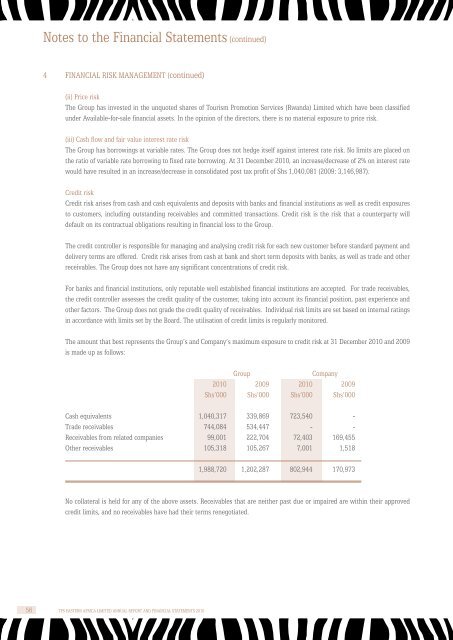TPSEAL 2010 Financial Results. - Serena Hotels
TPSEAL 2010 Financial Results. - Serena Hotels
TPSEAL 2010 Financial Results. - Serena Hotels
Create successful ePaper yourself
Turn your PDF publications into a flip-book with our unique Google optimized e-Paper software.
Notes to the <strong>Financial</strong> Statements (continued)<br />
4 <strong>Financial</strong> risk management (continued)<br />
(ii) Price risk<br />
The Group has invested in the unquoted shares of Tourism Promotion Services (Rwanda) Limited which have been classified<br />
under Available-for-sale financial assets. In the opinion of the directors, there is no material exposure to price risk.<br />
(iii) Cash flow and fair value interest rate risk<br />
The Group has borrowings at variable rates. The Group does not hedge itself against interest rate risk. No limits are placed on<br />
the ratio of variable rate borrowing to fixed rate borrowing. At 31 December <strong>2010</strong>, an increase/decrease of 2% on interest rate<br />
would have resulted in an increase/decrease in consolidated post tax profit of Shs 1,040,081 (2009: 3,146,987).<br />
Credit risk<br />
Credit risk arises from cash and cash equivalents and deposits with banks and financial institutions as well as credit exposures<br />
to customers, including outstanding receivables and committed transactions. Credit risk is the risk that a counterparty will<br />
default on its contractual obligations resulting in financial loss to the Group.<br />
The credit controller is responsible for managing and analysing credit risk for each new customer before standard payment and<br />
delivery terms are offered. Credit risk arises from cash at bank and short term deposits with banks, as well as trade and other<br />
receivables. The Group does not have any significant concentrations of credit risk.<br />
For banks and financial institutions, only reputable well established financial institutions are accepted. For trade receivables,<br />
the credit controller assesses the credit quality of the customer, taking into account its financial position, past experience and<br />
other factors. The Group does not grade the credit quality of receivables. Individual risk limits are set based on internal ratings<br />
in accordance with limits set by the Board. The utilisation of credit limits is regularly monitored.<br />
The amount that best represents the Group’s and Company’s maximum exposure to credit risk at 31 December <strong>2010</strong> and 2009<br />
is made up as follows:<br />
Group<br />
Company<br />
<strong>2010</strong> 2009 <strong>2010</strong> 2009<br />
Shs’000 Shs’000 Shs’000 Shs’000<br />
Cash equivalents 1,040,317 339,869 723,540 -<br />
Trade receivables 744,084 534,447 - -<br />
Receivables from related companies 99,001 222,704 72,403 169,455<br />
Other receivables 105,318 105,267 7,001 1,518<br />
1,988,720 1,202,287 802,944 170,973<br />
No collateral is held for any of the above assets. Receivables that are neither past due or impaired are within their approved<br />
credit limits, and no receivables have had their terms renegotiated.<br />
56 TPS EASTERN AFRICA LIMITED ANNUAL REPORT AND FINANCIAL STATEMENTS <strong>2010</strong>





